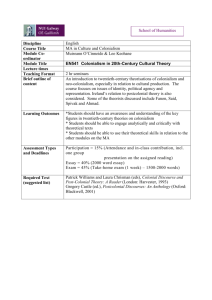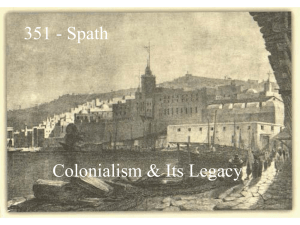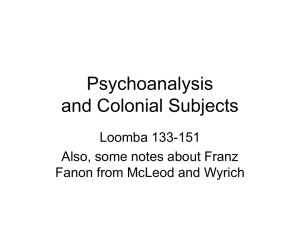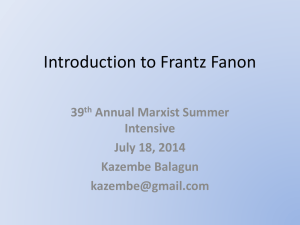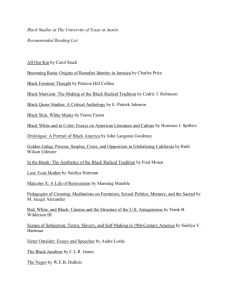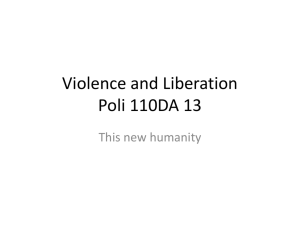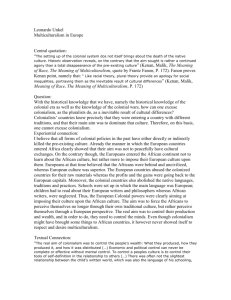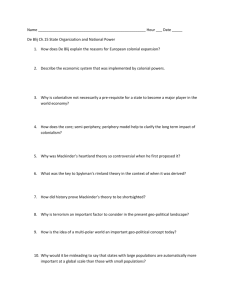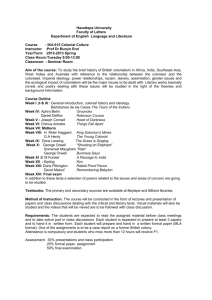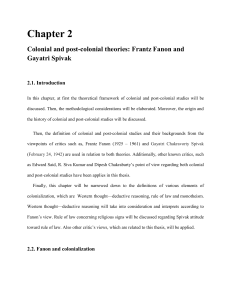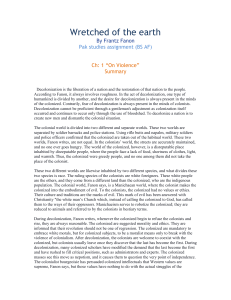Fanon - SOC 331: Foundations of Sociological Theory
advertisement
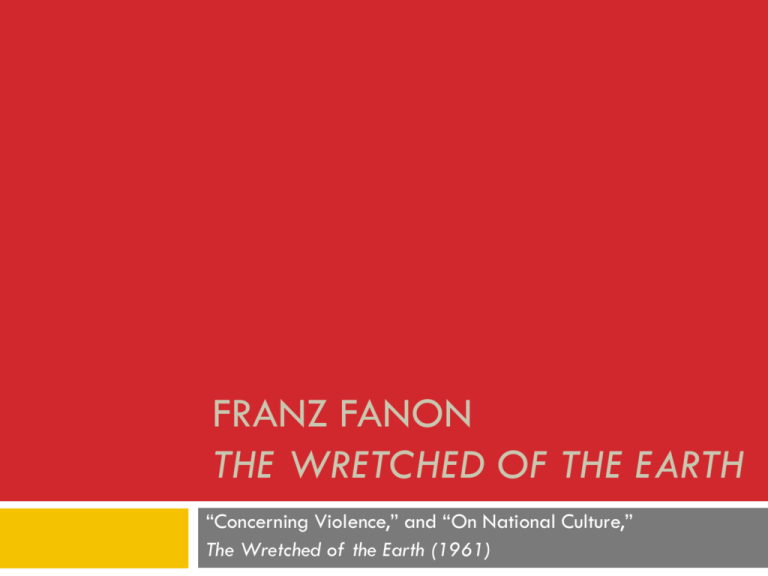
FRANZ FANON THE WRETCHED OF THE EARTH “Concerning Violence,” and “On National Culture,” The Wretched of the Earth (1961) Franz Fanon (1925-1961) 2 Born in Martinique, studied medicine in France, became a psychiatrist During French-Algierian war, Fanon served in a hospital in Algeria Died of cancer at age 36 Both Black Skin, White Masks (1952) and The Wretched (1961) early classics of late- and postcolonial literature Influences and key themes 3 Fanon uses Marxist theory, psychology, critical race theory, and global political economy in order to give an account of the colonized subject, the problem of nationalism, and the path to liberation Shows how colonized peoples also experience double consciousness (DuBois) Similarity of double consciousness between people of color in US & colonized people historically suggests connections between racism in US & colonialism internationally DuBois makes same argument in “Souls of White Folk” Postcolonial theory 4 Postcolonial theory: a set of theories in social science and literature that address the legacy of colonial rule and the struggle for political and cultural independence of peoples formerly subjugated in colonial empires Besides Fanon’s work, Edward Saïd's Orientalism (1978) is seminal book in the field Saïd analyzed the works of the Western canon, exploring how they both absorbed and helped to shape a societal fantasy of European racial superiority Inspired by Foucault, postcolonial theory emphasizes discourse, which joins power and knowledge Orientalism 5 Said took term Orientalism, used in the West neutrally to describe the study and artistic depiction of the Orient, and subverted it to mean a constructed binary division of the world into the Orient and the Occident East/West binary is key in postcolonial theory Said argued that the Occident could not exist without the Orient, and vice versa Occident & Orient, East & West, are mutually constitutive Concept of the ‘East’ was created by the ‘West,’ suppressing the ability of the ‘Orient’ to express themselves Western depictions of ‘Orient’ construct an inferior world, of backwardness, irrationality, and wildness The ‘West’ identify themselves as the opposite: a superior world, that’s progressive, rational, and civil The Wretched of the Earth 6 Fanon defines and explains colonialism and decolonization from a political, philosophical, historical, and socio-cultural perspective Defines colonialism and its constructs, the psychology of colonialism and its subtle effects on the colonized Colonization is a creation of two conflicting societies, one of the colonizer and one of the colonized Colonizer & colonized, settler & native, mutually constitutive Colonization barbarizes the colonized so that the colonizer can, in good conscience, take everything from the oppressed Colonialism 7 Colonialism is the establishment, maintenance, acquisition and expansion of colonies in one territory by people from another territory core/metropole claims sovereignty over the colony, and social structure, gov’t, and economics of the colony are changed by colonizers from the core Colonialism represents systematic underdevelopment of periphery to benefit of core Ideological basis of colonialism is racism/white supremacy “white man’s burden” collection of cultural images and themes by which colonized people came to be known by the colonial power Decolonization 8 The Wretched of the Earth served as the handbook for political leaders faced with decolonization Decolonization is not simply the removal of colonial structures, but especially, the deconstruction of colonial legacies in the mindset of formerly colonized peoples psychological dimensions of colonialism To end colonization, first the colonized must see the myth that has been placed on him “Concerning Violence” 9 Fanon offers a raw depiction of both the colonizer and the colonized, describing colonialism as a source of violence rather than reacting violently against resistors which had been the common view Describing how the two mutually constitute each other, Fanon shows how the violence of colonization both breeds and constrains violence within the colonized, simultaneously enabling their colonization and providing the very power through which the colonized might liberate themselves Such liberation is only possible, he claims, through revolutionary violence Colonialism is built on force 10 Barracks & police stations mark the frontiers of the divided colonial world In the colonies, the policeman and the soldier are the official, instituted gobetweens, the spokesmen of the settler and his rule of oppression In capitalist societies, institutions such as the educational system serve to create around the exploited an atmosphere of submission and of inhibition which lightens task of policing considerably In the colonial countries, by contrast, policeman and soldier, by their immediate presence and their frequent and direct action maintain contact with the native, using the language of pure force “The intermediary does not lighten the oppression, nor seek to hide the domination; he shows them up and puts them into practice with the clear conscience of an upholder of the peace; yet he is the bringer of violence into the home and into the mind of the native….” “On National Culture” 11 Fanon’s critique of nationalism and imperialism also develops to cover areas such as mental health and the role of intellectuals in revolutionary situations Fanon explains in great detail that revolutionary groups should look to the lumpenproletariat for the force needed to expel colonists The lumpenproletariat in traditional Marxist theories are considered the lowest, most degraded stratum of the proletariat, especially criminals, vagrants, and the unemployed, who lacked class consciousness Fanon uses the term to refer to those inhabitants of colonized countries who are not involved in industrial production, particularly peasants living outside the cities He argues that only this group, unlike the industrial proletariat, has sufficient independence from the colonists to successfully make a revolution against them Or do ‘riff-raff’ have revolutionary potential? 12 Bakunin,19th c. Russian revolutionary and anarchist, saw the revolutionary archetype in a peasant milieu (like Fanon) and among educated unemployed youth, assorted marginals from all classes, brigands, robbers, the impoverished masses, and those on the margins of society who have escaped, been excluded from, or not yet subsumed in the discipline of emerging industrial work ‘social dynamite’ (Spitzer)
